handbrake FIAT 500L LIVING 2015 2.G Owners Manual
[x] Cancel search | Manufacturer: FIAT, Model Year: 2015, Model line: 500L LIVING, Model: FIAT 500L LIVING 2015 2.GPages: 224, PDF Size: 5.92 MB
Page 4 of 224
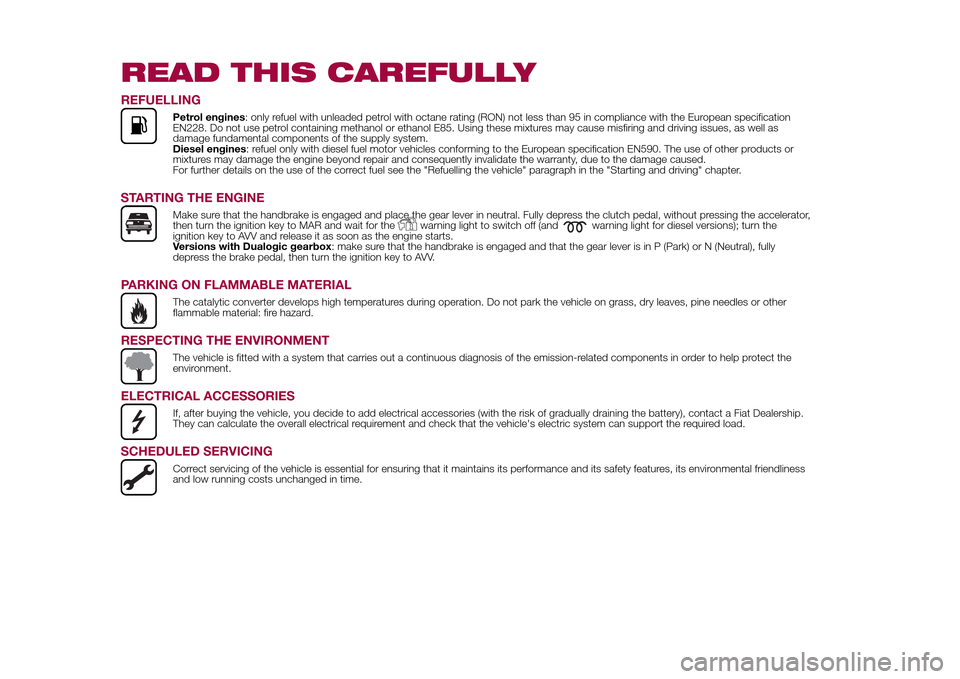
READ THIS CAREFULLYREFUELLING
Petrol engines: only refuel with unleaded petrol with octane rating (RON) not less than 95 in compliance with the European specification
EN228. Do not use petrol containing methanol or ethanol E85. Using these mixtures may cause misfiring and driving issues, as well as
damage fundamental components of the supply system.
Diesel engines: refuel only with diesel fuel motor vehicles conforming to the European specification EN590. The use of other products or
mixtures may damage the engine beyond repair and consequently invalidate the warranty, due to the damage caused.
For further details on the use of the correct fuel see the "Refuelling the vehicle" paragraph in the "Starting and driving" chapter.
STARTING THE ENGINE
Make sure that the handbrake is engaged and place the gear lever in neutral. Fully depress the clutch pedal, without pressing the accelerator,
then turn the ignition key to MAR and wait for the
warning light to switch off (and
warning light for diesel versions); turn the
ignition key to AVV and release it as soon as the engine starts.
Versions with Dualogic gearbox: make sure that the handbrake is engaged and that the gear lever is in P (Park) or N (Neutral), fully
depress the brake pedal, then turn the ignition key to AVV.
PARKING ON FLAMMABLE MATERIAL
The catalytic converter develops high temperatures during operation. Do not park the vehicle on grass, dry leaves, pine needles or other
flammable material: fire hazard.
RESPECTING THE ENVIRONMENT
The vehicle is fitted with a system that carries out a continuous diagnosis of the emission-related components in order to help protect the
environment.
ELECTRICAL ACCESSORIES
If, after buying the vehicle, you decide to add electrical accessories (with the risk of gradually draining the battery), contact a Fiat Dealership.
They can calculate the overall electrical requirement and check that the vehicle's electric system can support the required load.
SCHEDULED SERVICING
Correct servicing of the vehicle is essential for ensuring that it maintains its performance and its safety features, its environmental friendliness
and low running costs unchanged in time.
9-1-2015 12:9 Pagina 2
Page 12 of 224
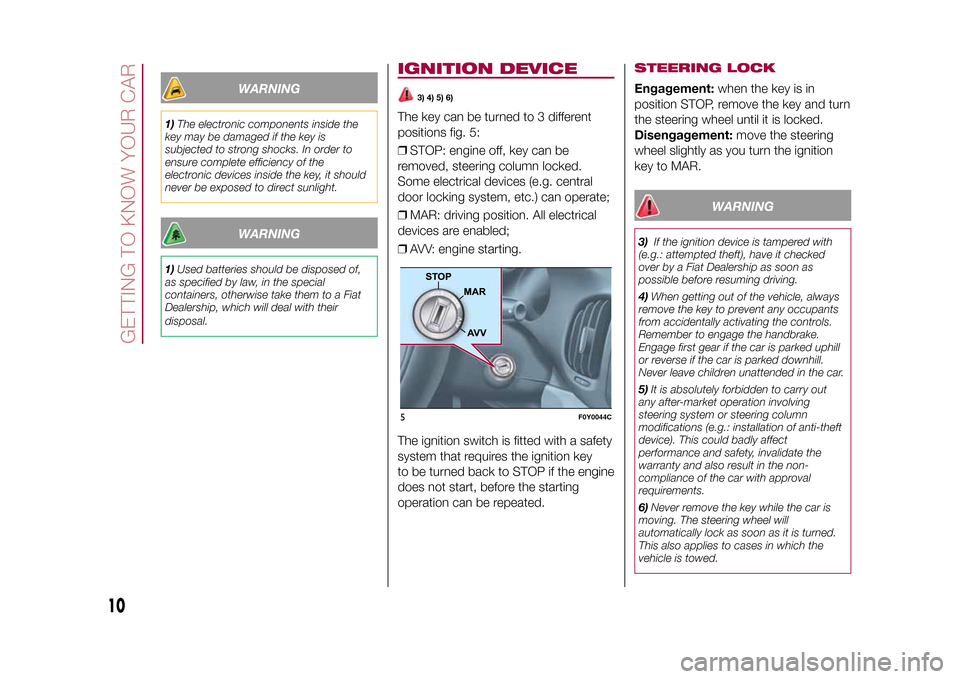
WARNING
1)The electronic components inside the
key may be damaged if the key is
subjected to strong shocks. In order to
ensure complete efficiency of the
electronic devices inside the key, it should
never be exposed to direct sunlight.
WARNING
1)Used batteries should be disposed of,
as specified by law, in the special
containers, otherwise take them to a Fiat
Dealership, which will deal with their
disposal.
IGNITION DEVICE
3) 4) 5) 6)
The key can be turned to 3 different
positions fig. 5:
❒STOP: engine off, key can be
removed, steering column locked.
Some electrical devices (e.g. central
door locking system, etc.) can operate;
❒MAR: driving position. All electrical
devices are enabled;
❒AVV: engine starting.
The ignition switch is fitted with a safety
system that requires the ignition key
to be turned back to STOP if the engine
does not start, before the starting
operation can be repeated.
STEERING LOCKEngagement:when the key is in
position STOP, remove the key and turn
the steering wheel until it is locked.
Disengagement:move the steering
wheel slightly as you turn the ignition
key to MAR.
WARNING
3)If the ignition device is tampered with
(e.g.: attempted theft), have it checked
over by a Fiat Dealership as soon as
possible before resuming driving.
4)When getting out of the vehicle, always
remove the key to prevent any occupants
from accidentally activating the controls.
Remember to engage the handbrake.
Engage first gear if the car is parked uphill
or reverse if the car is parked downhill.
Never leave children unattended in the car.
5)It is absolutely forbidden to carry out
any after-market operation involving
steering system or steering column
modifications (e.g.: installation of anti-theft
device). This could badly affect
performance and safety, invalidate the
warranty and also result in the non-
compliance of the car with approval
requirements.
6)Never remove the key while the car is
moving. The steering wheel will
automatically lock as soon as it is turned.
This also applies to cases in which the
vehicle is towed.
5
F0Y0044C
10
GETTING TO KNOW YOUR CAR
9-1-2015 12:9 Pagina 10
Page 47 of 224
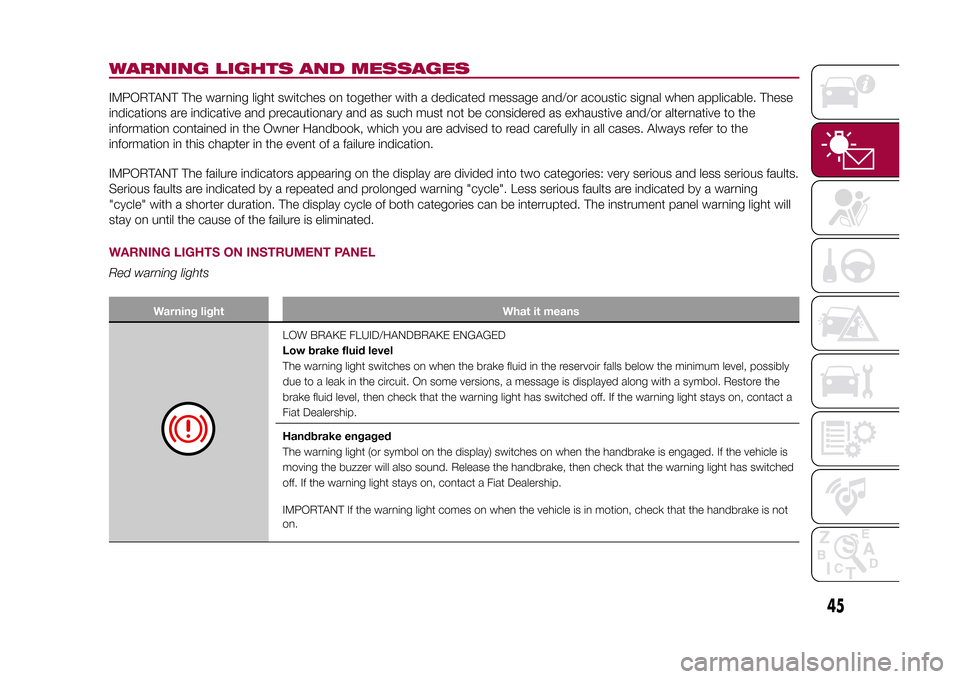
WARNING LIGHTS AND MESSAGESIMPORTANT The warning light switches on together with a dedicated message and/or acoustic signal when applicable. These
indications are indicative and precautionary and as such must not be considered as exhaustive and/or alternative to the
information contained in the Owner Handbook, which you are advised to read carefully in all cases. Always refer to the
information in this chapter in the event of a failure indication.
IMPORTANT The failure indicators appearing on the display are divided into two categories: very serious and less serious faults.
Serious faults are indicated by a repeated and prolonged warning "cycle". Less serious faults are indicated by a warning
"cycle" with a shorter duration. The display cycle of both categories can be interrupted. The instrument panel warning light will
stay on until the cause of the failure is eliminated.WARNING LIGHTS ON INSTRUMENT PANELRed warning lights
Warning light What it means
LOW BRAKE FLUID/HANDBRAKE ENGAGED
Low brake fluid level
The warning light switches on when the brake fluid in the reservoir falls below the minimum level, possibly
due to a leak in the circuit. On some versions, a message is displayed along with a symbol. Restore the
brake fluid level, then check that the warning light has switched off. If the warning light stays on, contact a
Fiat Dealership.
Handbrake engaged
The warning light (or symbol on the display) switches on when the handbrake is engaged. If the vehicle is
moving the buzzer will also sound. Release the handbrake, then check that the warning light has switched
off. If the warning light stays on, contact a Fiat Dealership.
IMPORTANT If the warning light comes on when the vehicle is in motion, check that the handbrake is not
on.
45
9-1-2015 12:9 Pagina 45
Page 69 of 224
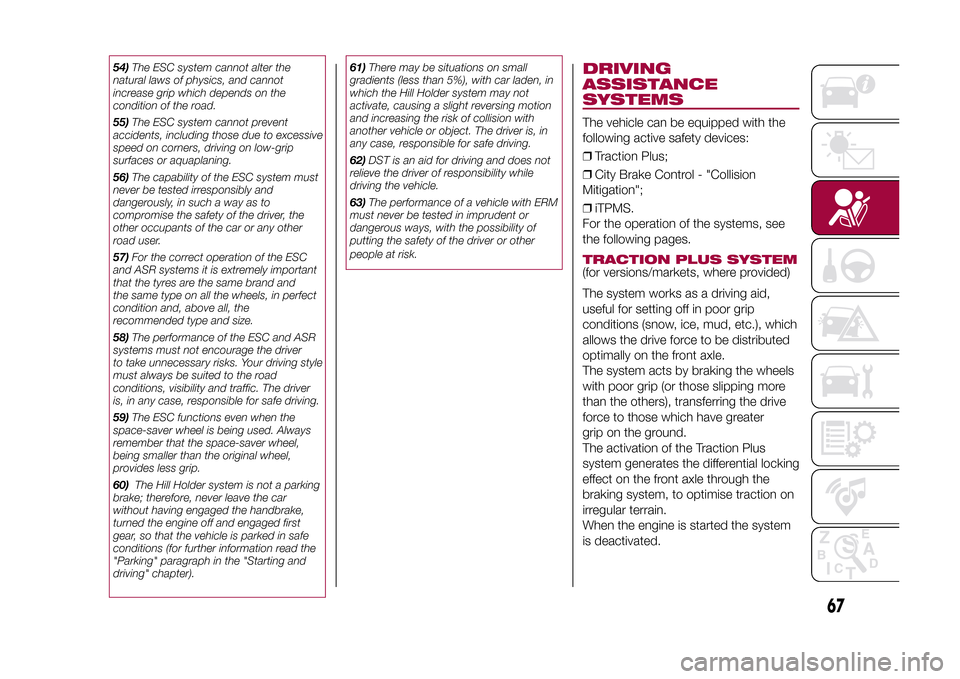
54)The ESC system cannot alter the
natural laws of physics, and cannot
increase grip which depends on the
condition of the road.
55)The ESC system cannot prevent
accidents, including those due to excessive
speed on corners, driving on low-grip
surfaces or aquaplaning.
56)The capability of the ESC system must
never be tested irresponsibly and
dangerously, in such a way as to
compromise the safety of the driver, the
other occupants of the car or any other
road user.
57)For the correct operation of the ESC
and ASR systems it is extremely important
that the tyres are the same brand and
the same type on all the wheels, in perfect
condition and, above all, the
recommended type and size.
58)The performance of the ESC and ASR
systems must not encourage the driver
to take unnecessary risks. Your driving style
must always be suited to the road
conditions, visibility and traffic. The driver
is, in any case, responsible for safe driving.
59)The ESC functions even when the
space-saver wheel is being used. Always
remember that the space-saver wheel,
being smaller than the original wheel,
provides less grip.
60)The Hill Holder system is not a parking
brake; therefore, never leave the car
without having engaged the handbrake,
turned the engine off and engaged first
gear, so that the vehicle is parked in safe
conditions (for further information read the
"Parking" paragraph in the "Starting and
driving" chapter).61)There may be situations on small
gradients (less than 5%), with car laden, in
which the Hill Holder system may not
activate, causing a slight reversing motion
and increasing the risk of collision with
another vehicle or object. The driver is, in
any case, responsible for safe driving.
62)DST is an aid for driving and does not
relieve the driver of responsibility while
driving the vehicle.
63)The performance of a vehicle with ERM
must never be tested in imprudent or
dangerous ways, with the possibility of
putting the safety of the driver or other
people at risk.
DRIVING
ASSISTANCE
SYSTEMSThe vehicle can be equipped with the
following active safety devices:
❒Traction Plus;
❒City Brake Control - "Collision
Mitigation";
❒iTPMS.
For the operation of the systems, see
the following pages.TRACTION PLUS SYSTEM(for versions/markets, where provided)
The system works as a driving aid,
useful for setting off in poor grip
conditions (snow, ice, mud, etc.), which
allows the drive force to be distributed
optimally on the front axle.
The system acts by braking the wheels
with poor grip (or those slipping more
than the others), transferring the drive
force to those which have greater
grip on the ground.
The activation of the Traction Plus
system generates the differential locking
effect on the front axle through the
braking system, to optimise traction on
irregular terrain.
When the engine is started the system
is deactivated.
67
9-1-2015 12:9 Pagina 67
Page 94 of 224
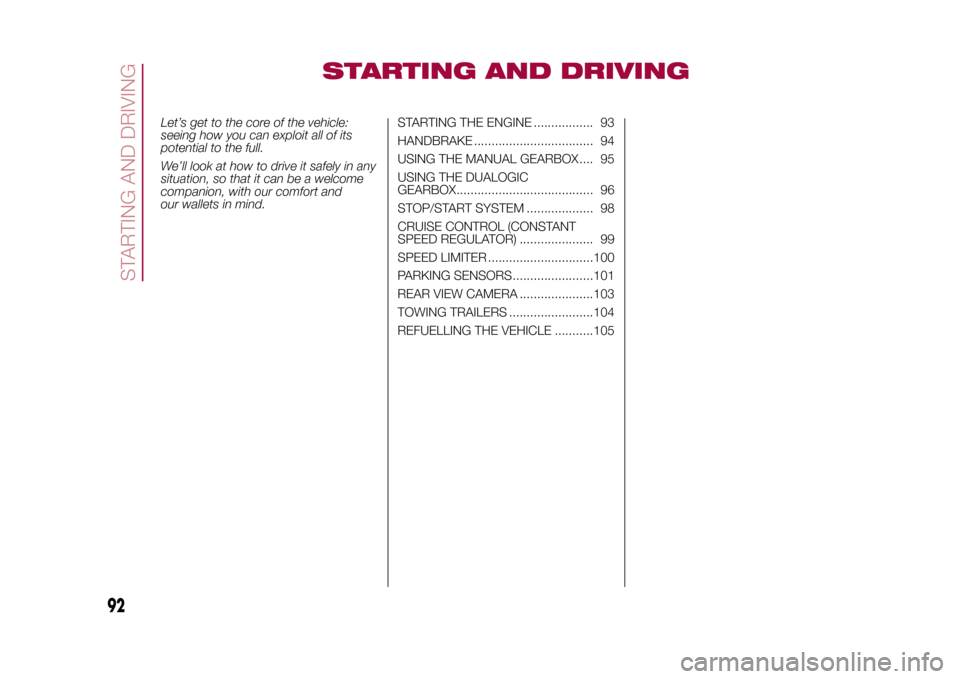
STARTING AND DRIVING
Let’s get to the core of the vehicle:
seeing how you can exploit all of its
potential to the full.
We’ll look at how to drive it safely in any
situation, so that it can be a welcome
companion, with our comfort and
our wallets in mind.STARTING THE ENGINE ................. 93
HANDBRAKE .................................. 94
USING THE MANUAL GEARBOX .... 95
USING THE DUALOGIC
GEARBOX....................................... 96
STOP/START SYSTEM ................... 98
CRUISE CONTROL (CONSTANT
SPEED REGULATOR) ..................... 99
SPEED LIMITER ..............................100
PARKING SENSORS.......................101
REAR VIEW CAMERA .....................103
TOWING TRAILERS ........................104
REFUELLING THE VEHICLE ...........105
92
STARTING AND DRIVING
9-1-2015 12:9 Pagina 92
Page 95 of 224
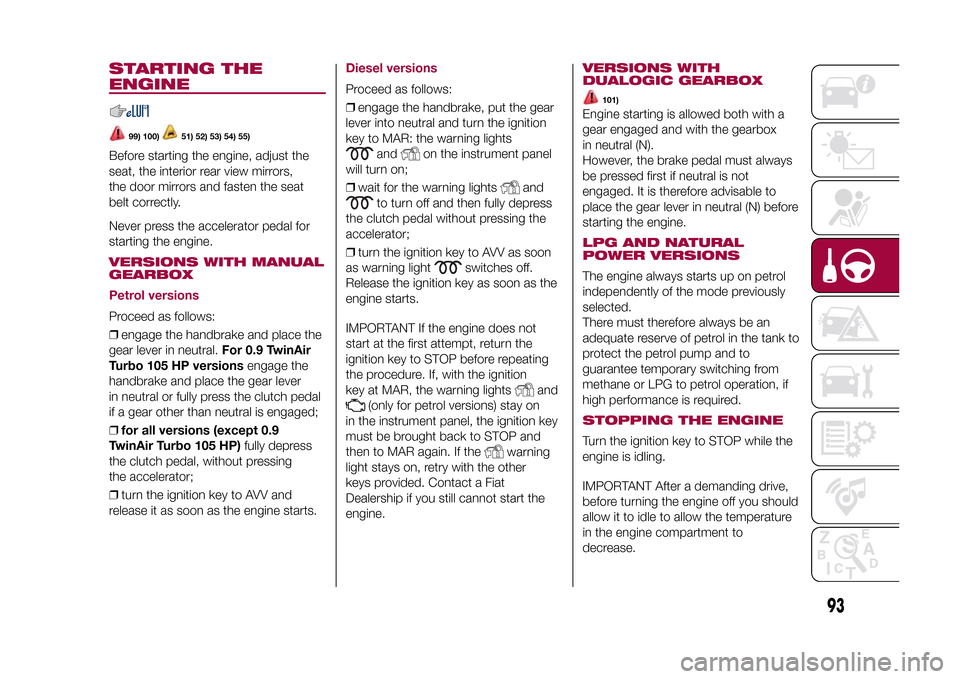
STARTING THE
ENGINE
99) 100)
51) 52) 53) 54) 55)
Before starting the engine, adjust the
seat, the interior rear view mirrors,
the door mirrors and fasten the seat
belt correctly.
Never press the accelerator pedal for
starting the engine.VERSIONS WITH MANUAL
GEARBOX
Petrol versionsProceed as follows:
❒engage the handbrake and place the
gear lever in neutral.For 0.9 TwinAir
Turbo 105 HP versionsengage the
handbrake and place the gear lever
in neutral or fully press the clutch pedal
if a gear other than neutral is engaged;
❒for all versions (except 0.9
TwinAir Turbo 105 HP)fully depress
the clutch pedal, without pressing
the accelerator;
❒turn the ignition key to AVV and
release it as soon as the engine starts.
Diesel versionsProceed as follows:
❒engage the handbrake, put the gear
lever into neutral and turn the ignition
key to MAR: the warning lights
and
on the instrument panel
will turn on;
❒wait for the warning lights
and
to turn off and then fully depress
the clutch pedal without pressing the
accelerator;
❒turn the ignition key to AVV as soon
as warning light
switches off.
Release the ignition key as soon as the
engine starts.
IMPORTANT If the engine does not
start at the first attempt, return the
ignition key to STOP before repeating
the procedure. If, with the ignition
key at MAR, the warning lights
and
(only for petrol versions) stay on
in the instrument panel, the ignition key
must be brought back to STOP and
then to MAR again. If the
warning
light stays on, retry with the other
keys provided. Contact a Fiat
Dealership if you still cannot start the
engine.
VERSIONS WITH
DUALOGIC GEARBOX
101)
Engine starting is allowed both with a
gear engaged and with the gearbox
in neutral (N).
However, the brake pedal must always
be pressed first if neutral is not
engaged. It is therefore advisable to
place the gear lever in neutral (N) before
starting the engine.LPG AND NATURAL
POWER VERSIONSThe engine always starts up on petrol
independently of the mode previously
selected.
There must therefore always be an
adequate reserve of petrol in the tank to
protect the petrol pump and to
guarantee temporary switching from
methane or LPG to petrol operation, if
high performance is required.STOPPING THE ENGINETurn the ignition key to STOP while the
engine is idling.
IMPORTANT After a demanding drive,
before turning the engine off you should
allow it to idle to allow the temperature
in the engine compartment to
decrease.
93
9-1-2015 12:9 Pagina 93
Page 96 of 224
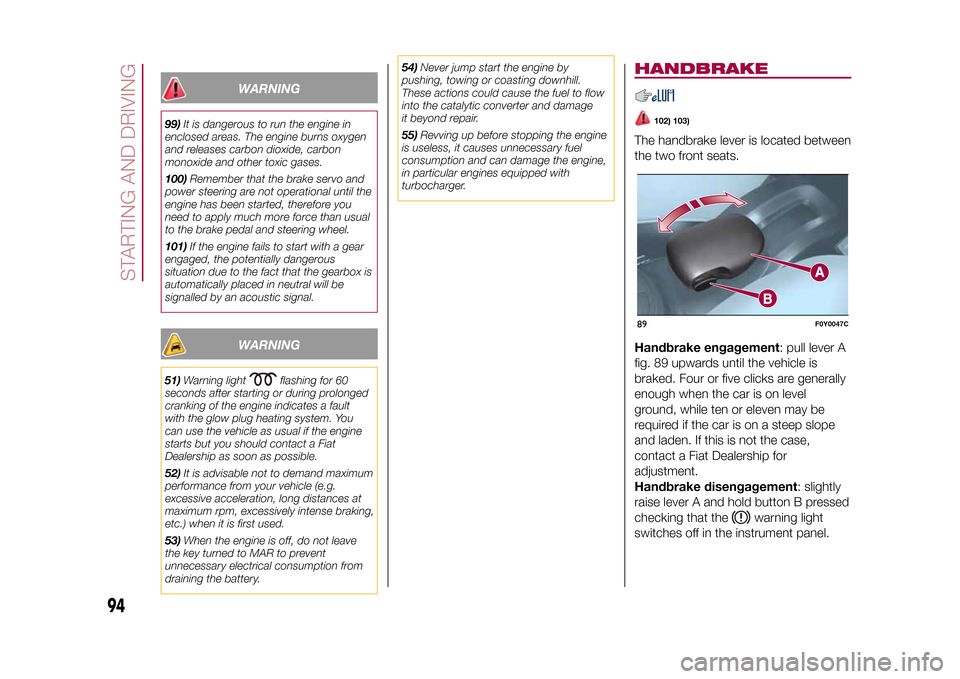
WARNING
99)It is dangerous to run the engine in
enclosed areas. The engine burns oxygen
and releases carbon dioxide, carbon
monoxide and other toxic gases.
100)Remember that the brake servo and
power steering are not operational until the
engine has been started, therefore you
need to apply much more force than usual
to the brake pedal and steering wheel.
101)If the engine fails to start with a gear
engaged, the potentially dangerous
situation due to the fact that the gearbox is
automatically placed in neutral will be
signalled by an acoustic signal.
WARNING
51)Warning light
flashing for 60
seconds after starting or during prolonged
cranking of the engine indicates a fault
with the glow plug heating system. You
can use the vehicle as usual if the engine
starts but you should contact a Fiat
Dealership as soon as possible.
52)It is advisable not to demand maximum
performance from your vehicle (e.g.
excessive acceleration, long distances at
maximum rpm, excessively intense braking,
etc.) when it is first used.
53)When the engine is off, do not leave
the key turned to MAR to prevent
unnecessary electrical consumption from
draining the battery.54)Never jump start the engine by
pushing, towing or coasting downhill.
These actions could cause the fuel to flow
into the catalytic converter and damage
it beyond repair.
55)Revving up before stopping the engine
is useless, it causes unnecessary fuel
consumption and can damage the engine,
in particular engines equipped with
turbocharger.
HANDBRAKE
102) 103)
The handbrake lever is located between
the two front seats.
Handbrake engagement: pull lever A
fig. 89 upwards until the vehicle is
braked. Four or five clicks are generally
enough when the car is on level
ground, while ten or eleven may be
required if the car is on a steep slope
and laden. If this is not the case,
contact a Fiat Dealership for
adjustment.
Handbrake disengagement: slightly
raise lever A and hold button B pressed
checking that the
warning light
switches off in the instrument panel.
89
F0Y0047C
94
STARTING AND DRIVING
9-1-2015 12:9 Pagina 94
Page 97 of 224
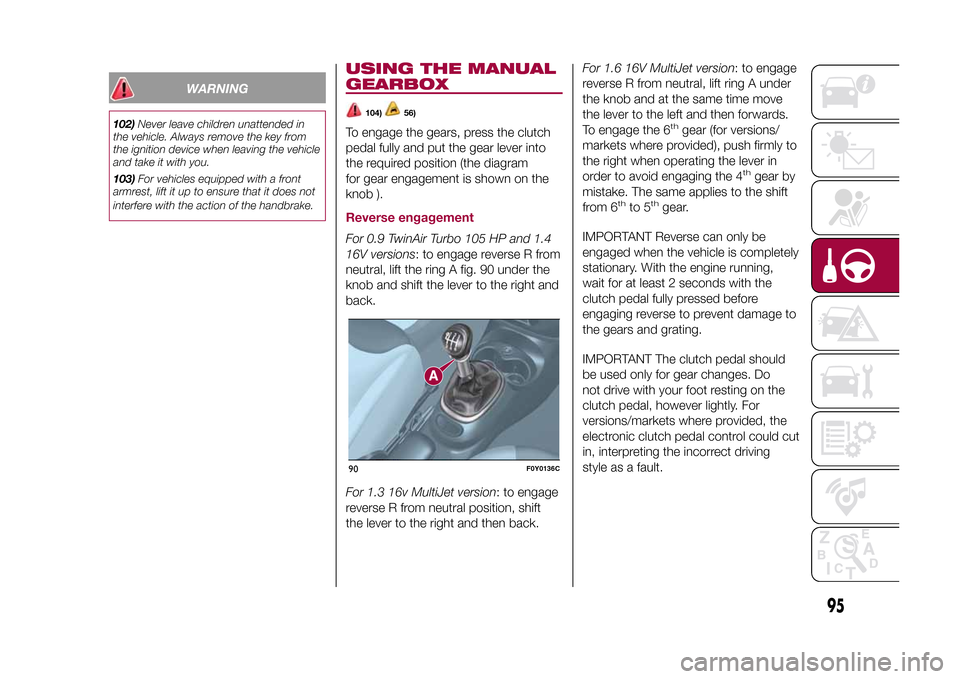
WARNING
102)Never leave children unattended in
the vehicle. Always remove the key from
the ignition device when leaving the vehicle
and take it with you.
103)For vehicles equipped with a front
armrest, lift it up to ensure that it does not
interfere with the action of the handbrake.
USING THE MANUAL
GEARBOX
104)
56)
To engage the gears, press the clutch
pedal fully and put the gear lever into
the required position (the diagram
for gear engagement is shown on the
knob ).Reverse engagementFor 0.9 TwinAir Turbo 105 HP and 1.4
16V versions: to engage reverse R from
neutral, lift the ring A fig. 90 under the
knob and shift the lever to the right and
back.
For 1.3 16v MultiJet version: to engage
reverse R from neutral position, shift
the lever to the right and then back.For 1.6 16V MultiJet version: to engage
reverse R from neutral, lift ring A under
the knob and at the same time move
the lever to the left and then forwards.
To engage the 6
th
gear (for versions/
markets where provided), push firmly to
the right when operating the lever in
order to avoid engaging the 4
th
gear by
mistake. The same applies to the shift
from 6
th
to 5
th
gear.
IMPORTANT Reverse can only be
engaged when the vehicle is completely
stationary. With the engine running,
wait for at least 2 seconds with the
clutch pedal fully pressed before
engaging reverse to prevent damage to
the gears and grating.
IMPORTANT The clutch pedal should
be used only for gear changes. Do
not drive with your foot resting on the
clutch pedal, however lightly. For
versions/markets where provided, the
electronic clutch pedal control could cut
in, interpreting the incorrect driving
style as a fault.
90
F0Y0136C
95
9-1-2015 12:9 Pagina 95
Page 107 of 224
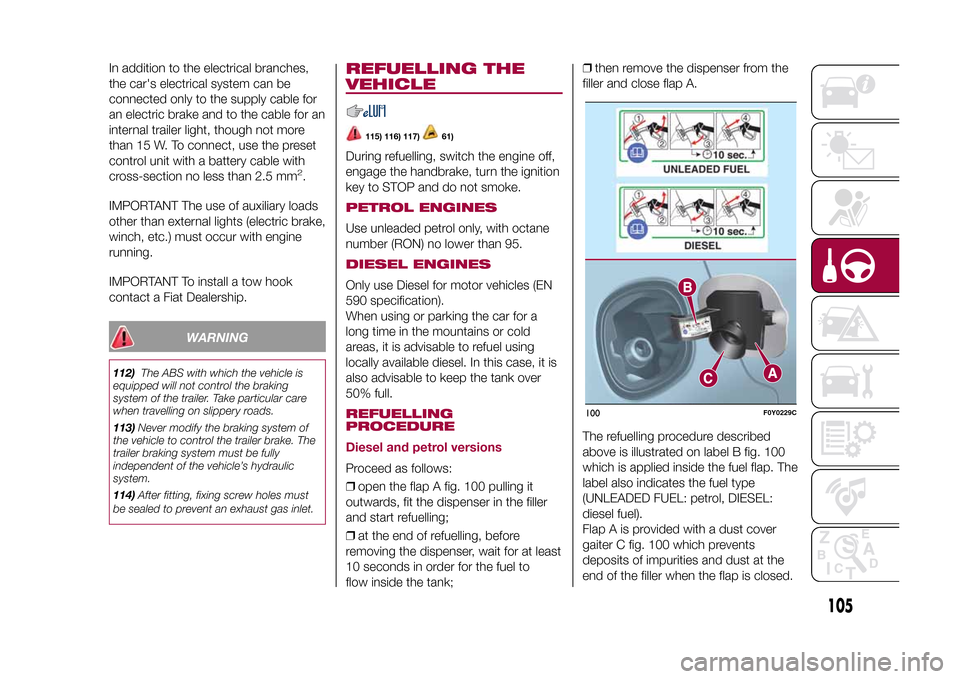
In addition to the electrical branches,
the car's electrical system can be
connected only to the supply cable for
an electric brake and to the cable for an
internal trailer light, though not more
than 15 W. To connect, use the preset
control unit with a battery cable with
cross-section no less than 2.5 mm
2.
IMPORTANT The use of auxiliary loads
other than external lights (electric brake,
winch, etc.) must occur with engine
running.
IMPORTANT To install a tow hook
contact a Fiat Dealership.
WARNING
112)The ABS with which the vehicle is
equipped will not control the braking
system of the trailer. Take particular care
when travelling on slippery roads.
113)Never modify the braking system of
the vehicle to control the trailer brake. The
trailer braking system must be fully
independent of the vehicle’s hydraulic
system.
114)After fitting, fixing screw holes must
be sealed to prevent an exhaust gas inlet.
REFUELLING THE
VEHICLE
115) 116) 117)
61)
During refuelling, switch the engine off,
engage the handbrake, turn the ignition
key to STOP and do not smoke.PETROL ENGINESUse unleaded petrol only, with octane
number (RON) no lower than 95.DIESEL ENGINESOnly use Diesel for motor vehicles (EN
590 specification).
When using or parking the car for a
long time in the mountains or cold
areas, it is advisable to refuel using
locally available diesel. In this case, it is
also advisable to keep the tank over
50% full.REFUELLING
PROCEDURE
Diesel and petrol versionsProceed as follows:
❒open the flap A fig. 100 pulling it
outwards, fit the dispenser in the filler
and start refuelling;
❒at the end of refuelling, before
removing the dispenser, wait for at least
10 seconds in order for the fuel to
flow inside the tank;❒then remove the dispenser from the
filler and close flap A.
The refuelling procedure described
above is illustrated on label B fig. 100
which is applied inside the fuel flap. The
label also indicates the fuel type
(UNLEADED FUEL: petrol, DIESEL:
diesel fuel).
Flap A is provided with a dust cover
gaiter C fig. 100 which prevents
deposits of impurities and dust at the
end of the filler when the flap is closed.
100
F0Y0229C
105
9-1-2015 12:9 Pagina 105
Page 111 of 224
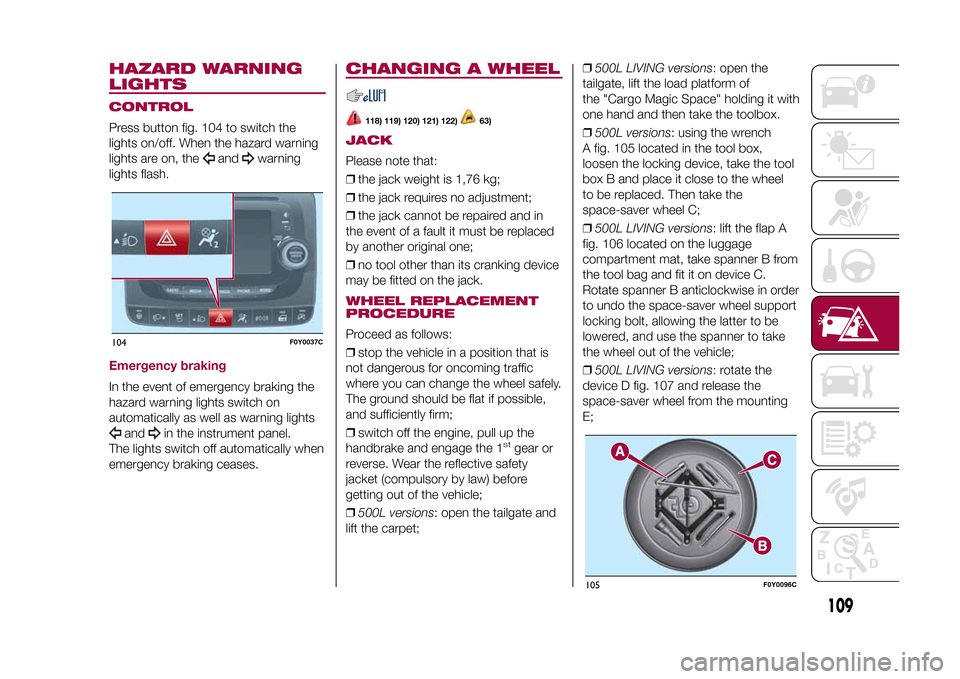
HAZARD WARNING
LIGHTSCONTROLPress button fig. 104 to switch the
lights on/off. When the hazard warning
lights are on, the
and
warning
lights flash.
Emergency brakingIn the event of emergency braking the
hazard warning lights switch on
automatically as well as warning lights
and
in the instrument panel.
The lights switch off automatically when
emergency braking ceases.
CHANGING A WHEEL
118) 119) 120) 121) 122)
63)
JACKPlease note that:
❒the jack weight is 1,76 kg;
❒the jack requires no adjustment;
❒the jack cannot be repaired and in
the event of a fault it must be replaced
by another original one;
❒no tool other than its cranking device
may be fitted on the jack.WHEEL REPLACEMENT
PROCEDUREProceed as follows:
❒stop the vehicle in a position that is
not dangerous for oncoming traffic
where you can change the wheel safely.
The ground should be flat if possible,
and sufficiently firm;
❒switch off the engine, pull up the
handbrake and engage the 1
stgear or
reverse. Wear the reflective safety
jacket (compulsory by law) before
getting out of the vehicle;
❒500L versions: open the tailgate and
lift the carpet;❒500L LIVING versions: open the
tailgate, lift the load platform of
the "Cargo Magic Space" holding it with
one hand and then take the toolbox.
❒500L versions: using the wrench
A fig. 105 located in the tool box,
loosen the locking device, take the tool
box B and place it close to the wheel
to be replaced. Then take the
space-saver wheel C;
❒500L LIVING versions: lift the flap A
fig. 106 located on the luggage
compartment mat, take spanner B from
the tool bag and fit it on device C.
Rotate spanner B anticlockwise in order
to undo the space-saver wheel support
locking bolt, allowing the latter to be
lowered, and use the spanner to take
the wheel out of the vehicle;
❒500L LIVING versions: rotate the
device D fig. 107 and release the
space-saver wheel from the mounting
E;
104
F0Y0037C
105
F0Y0096C
109
9-1-2015 12:9 Pagina 109